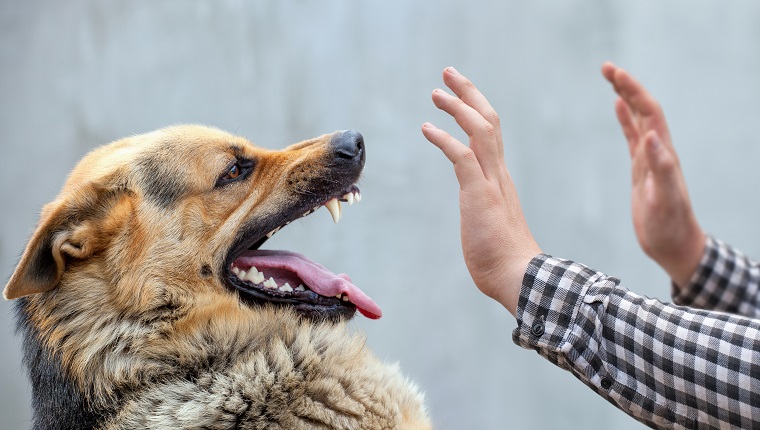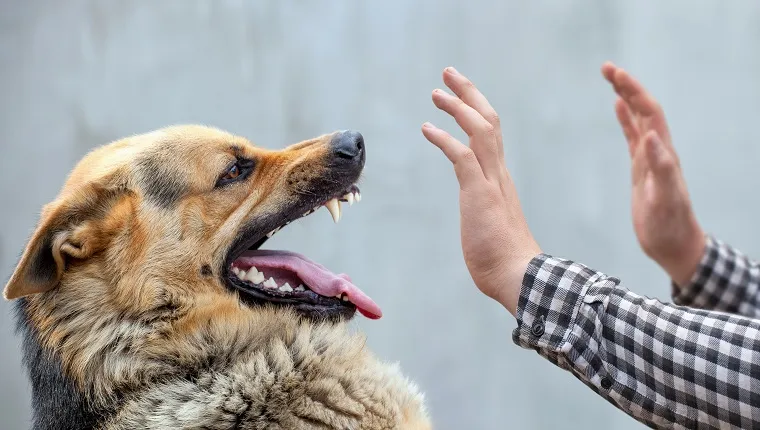Dog aggression toward people can be caused by various factors, such as fear, anxiety, lack of socialization, territorial behavior, and past trauma or abuse. The best way to treat and prevent aggression in dogs is through behavior modification, guided by a qualified professional.
This involves rewarding the dog for good behavior, using praise, treats, and toys. Obedience training and establishing yourself as the pack leader can also help with protective aggression. Seeking professional advice early on is crucial, as practicing aggressive behaviors can make the problem worse.
Neutering or spaying your dog as early as possible can also reduce hormone-driven aggression. It is important to always treat your dog with kindness and patience to foster a positive and non-aggressive behavior.
Understanding Dog Aggression Toward People
Understanding dog aggression toward people involves identifying causes, implementing treatment, and focusing on prevention. Behavior modification with professional guidance is a safe and effective way to address aggression issues. Neutering or spaying your dog early can also help reduce hormone-driven aggressive behavior.
Causes Of Dog Aggression
Aggressive behavior in dogs towards people can be caused by various factors. Some common causes include:- Lack of Socialization: Dogs that have not been properly socialized during their crucial developmental period may become fearful or aggressive towards people.
- Fear and Anxiety: Dogs that have experienced traumatic events or have a fearful temperament may exhibit aggression as a defensive response to perceived threats.
- Territorial Behavior: Dogs that are overly possessive of their territory may show aggression towards unfamiliar people who enter their space.
- Pain or Illness: Dogs experiencing physical pain or discomfort may exhibit aggression as a way to protect themselves.
- Past Trauma or Abuse: Dogs that have been subjected to abuse or traumatic experiences may develop aggressive tendencies towards people as a result.
Types Of Aggressive Dogs
Not all dogs exhibit aggression towards people, but certain breeds may be more prone to such behavior. It is important to note that aggression in dogs is not solely determined by their breed, as individual temperament and upbringing play significant roles. However, some breeds that have been observed to be more likely to display aggressive behavior include:| Breed | Description |
|---|---|
| Rottweiler | A strong and protective breed, often known for their territorial nature. |
| Dobermann | An intelligent and loyal breed that can be prone to protectiveness and aggression if not properly trained and socialized. |
| German Shepherd | A highly intelligent and trainable breed that may display aggression if not properly socialized or trained. |
| Chow Chow | A breed known for its independence and strong-willed nature, which may contribute to aggressive behavior. |
| Alaskan Malamute | Originally bred as sled dogs, Alaskan Malamutes can exhibit aggression if not properly trained and socialized. |
| Chihuahua | While small in size, Chihuahuas can display aggression if not properly trained and socialized. |

Credit: dogtime.com
Treatment Options For Dog Aggression
Reduce hormone-driven aggressive behavior in your dog by neutering or spaying them early. Seek professional advice and implement behavior modification techniques, rewarding good behavior with praise, treats, and toys. Remember that aggression won’t simply go away on its own and should be addressed promptly.
Implementing Behavior Modification
One of the most effective treatment options for dog aggression is implementing behavior modification techniques. This involves working with a qualified professional to identify the root cause of your dog’s aggression and develop a comprehensive training plan. The goal of behavior modification is to reinforce positive behaviors and discourage aggressive responses. Through consistent and structured training sessions, your dog can learn alternative behaviors and develop better coping mechanisms. This method is based on positive reinforcement, which involves rewarding your dog for displaying appropriate behavior through praise, treats, and toys.Obedience Training For Overprotective Dogs
For dogs that display overprotective behavior, obedience training can be an effective treatment option. This type of training helps establish a clear hierarchy in the household and reinforces your role as the pack leader. By setting boundaries and enforcing rules, you can help your dog understand that they do not need to be overly protective. Obedience training typically involves teaching basic commands such as sit, stay, and come. Regular training sessions, both at home and in a controlled environment such as a training class, can help improve your dog’s overall behavior and reduce aggression.Seeking Professional Advice
It is important to seek professional advice when dealing with dog aggression. Aggression issues should not be taken lightly, as they can pose a risk to both the dog and those around them. Consulting with a professional, such as a certified dog behaviorist or trainer, can help determine the underlying causes of aggression and create a customized treatment plan. Professional guidance ensures that you are using the most effective and safe methods to address your dog’s aggression. Remember, aggression will not simply go away on its own, and seeking professional advice early on can lead to the best outcomes for your dog’s behavior.Training An Aggressive Dog
Training an aggressive dog requires patience, consistency, and a methodical approach. It is important to understand that each dog is unique, and what works for one may not work for another. When training an aggressive dog, it is crucial to address any underlying issues, such as fear, anxiety, or past traumatic experiences. This may require desensitization exercises, counterconditioning techniques, and gradual exposure to trigger situations. It is recommended to work with a professional who specializes in aggressive dog behavior to ensure the safety of both you and your dog. With proper training and guidance, it is possible to modify aggressive behavior and help your dog become a well-adjusted and happier companion.Preventing Dog Aggression
Dog aggression toward people can be caused by various factors, but it can be treated and prevented through behavior modification techniques implemented by a qualified professional. Rewarding good behavior and providing obedience training can help improve your dog’s overall behavior and reduce aggression.
Neutering or spaying your dog early on can also significantly reduce hormone-driven aggression.
Neutering Or Spaying
Neutering or spaying your dog can play a significant role in preventing dog aggression. This procedure involves the removal of the dog’s reproductive organs, reducing hormone levels that can contribute to aggression. The American Society for the Prevention of Cruelty to Animals (ASPCA) affirms that neutering a male dog can reduce aggression towards both humans and other animals. Similarly, spaying a female dog can help manage aggressive behavior caused by hormonal fluctuations during heat cycles.Treating Dogs With Kindness
Treating dogs with kindness and compassion is essential for preventing aggression. Positive reinforcement training methods, such as rewarding good behavior with treats and praise, are more effective than punishment-based training techniques. When dogs are consistently treated with kindness, they develop trust and a positive association with humans, reducing the likelihood of aggressive behavior. Remember, a gentle approach combined with patience and consistency goes a long way in preventing dog aggression.Addressing Pain And Medical Problems
Addressing pain and medical problems is crucial in preventing dog aggression. Dogs may display aggressive behavior as a result of pain from injuries, dental issues, or underlying medical conditions. Regular veterinary check-ups and prompt treatment of any health problems can help alleviate discomfort and reduce the chances of aggression. It’s essential to be aware of any signs of pain or discomfort in your dog, such as limping, excessive panting, or changes in appetite, as these could be indicators of an underlying issue that needs attention. In addition to these proactive measures in preventing dog aggression, remember that early socialization, consistent obedience training, and a safe and enriched environment are also key factors in raising a well-adjusted and non-aggressive dog. By taking a proactive approach and ensuring a nurturing and positive environment for your furry friend, you can greatly reduce the risk of dog aggression.
Credit: resources.bestfriends.org
Common Reasons For Dog Aggression Toward People
Understanding the common reasons for dog aggression toward people is crucial to effectively address and prevent these behaviors. Aggression in dogs can manifest in various ways, and it’s essential to identify the underlying causes to determine the appropriate treatment and prevention methods. Here are some of the common reasons for dog aggression toward people:
Conflict Aggression
Conflict aggression occurs when a dog feels threatened or challenged by a person. This aggression is often displayed when the dog perceives a risk to their resources, such as food, water, toys, or territory. Dogs may exhibit warning signs, such as growling or snapping, to communicate their discomfort in such situations.
Fear-based Aggression
Fear-based aggression is rooted in a dog’s fear or anxiety toward people. Dogs with a history of traumatic experiences or lacking proper socialization may display fear-based aggression when they feel threatened or overwhelmed. They may become defensive and show defensive behaviors like barking, lunging, or biting to protect themselves.
Defensive Aggression
Defensive aggression occurs when a dog perceives a threat and resorts to aggressive behaviors to defend themselves. This type of aggression is often seen when a person approaches a dog too quickly or invades their personal space. Dogs may exhibit defensive behaviors, including barking, growling, and biting when they feel cornered or trapped.
Status-related Aggression
Status-related aggression is often seen in dominant dogs, where they display aggression to establish dominance over people. These dogs may show aggressive behaviors to assert their authority or control in social interactions. They may challenge or show aggression towards people who they perceive as lower in status.
Possessive Aggression
Possessive aggression occurs when a dog becomes protective or possessive over resources such as food, toys, or their territory. Dogs may display aggressive behaviors when someone approaches or tries to take away their valued possessions. This aggression can escalate quickly, and it’s important to address possessive behaviors early.
Food Guarding Aggression
Dogs with a history of resource guarding may display food guarding aggression. These dogs become defensive or aggressive when people or other animals approach them while they’re eating. They may growl, snap, or show other defensive behaviors to protect their food from perceived threats.
Redirected Aggression
Redirected aggression occurs when a dog is unable to display aggression towards their intended target and redirects it onto a person instead. This can happen when a dog becomes overstimulated, frustrated, or aroused by a particular stimulus or event. The dog may then redirect their aggression onto the nearest person, causing an unexpected and potentially dangerous attack.
Resources For Managing Dog Aggression
Dog aggression toward people can be a serious issue that requires professional intervention and proper management. If your dog is displaying signs of aggression, it is crucial to seek the help of a veterinarian and a qualified trainer to assess the situation and provide appropriate guidance. With the right resources and treatment, it is possible to address and manage dog aggression effectively.
Consulting A Veterinarian And Qualified Trainer
When dealing with dog aggression, it is essential to consult a veterinarian and a qualified trainer who specialize in dog behavior. A veterinarian can help rule out any medical causes for the aggression and may recommend specific tests or examinations to identify underlying issues that could be contributing to the behavior. They can also provide guidance on the best approach and potential treatment options.
A qualified trainer with experience in working with aggressive dogs can assess the behavior, provide tailored training techniques, and design a behavior modification plan to address and manage the aggression. They will guide you through the process of understanding the root causes of the aggression, implementing appropriate training methods, and reinforcing positive behaviors.
Aggression Prevention And Treatment
Preventing and treating dog aggression requires a combination of professional guidance, patience, and consistency. By identifying the triggers and situations that provoke aggression, you can work towards desensitizing and counter-conditioning your dog to respond differently.
Some resources for managing dog aggression include:
- Avoidance and management techniques: This involves preventing your dog from being exposed to situations that trigger aggression. It may include using muzzles, leashes, and barriers to ensure the safety of both your dog and others.
- Positive reinforcement training: Reward-based training techniques can help redirect your dog’s focus and teach appropriate behavior. By rewarding calm and non-aggressive responses, you can reinforce positive behaviors and reduce aggression.
- Behavior modification exercises: Controlled exposure to stimuli that elicit aggression, in a safe and controlled environment, can be utilized to modify your dog’s response. Gradual desensitization and counter-conditioning techniques can help change your dog’s emotional association with triggers.
- Medication: In severe cases, medication prescribed by a veterinarian might be necessary to help manage your dog’s aggression. Medication can assist in reducing anxiety, fear, or any underlying medical conditions that contribute to aggression.
Remember that managing dog aggression requires dedication, consistency, and professional guidance. It is crucial to have realistic expectations and understand that complete resolution may not be possible in every case. However, with proper care, intervention, and ongoing support, significant progress can be made in managing and improving your dog’s behavior.
:strip_icc()/dogs-and-aggression-1118229_source_file-3230147e3a8247789205e7e6a5da0cd3.jpg)
Credit: www.thesprucepets.com
Frequently Asked Questions Of Dog Aggression Toward People: Causes, Treatment, & Prevention
What Is The Best Treatment For Aggressive Dogs?
The best treatment for aggressive dogs is behavior modification through professional guidance. It involves rewarding good behavior and using positive reinforcement like praise, treats, and toys. Seek professional advice to address aggression early as it won’t go away on its own.
Neutering or spaying your dog can also help reduce hormone-driven aggression. Always treat your dog with kindness.
How Do You Fix Protective Aggression In Dogs?
To fix protective aggression in dogs, try obedience training at home or in classes. Do one or two training sessions daily, even if they’re short. This establishes you as the boss and improves their behavior. Seek professional advice if needed, as aggression won’t go away on its own.
Can Dog Aggression Be Solved?
Yes, dog aggression can be solved with the help of professional guidance and behavior modification techniques. Seeking professional advice early on is crucial as practiced behaviors tend to improve. Aggression will not go away on its own, but with the right support, it can be successfully resolved.
Can You Train Aggression Out Of A Dog?
You can train aggression out of a dog, but it depends on the severity and cause of the aggression. Factors like fear, anxiety, lack of socialization, and past trauma can contribute to aggression. Seek professional guidance to implement behavior modification techniques and address the underlying issues.
Conclusion
Preventing and treating dog aggression toward people is crucial for the safety and well-being of both humans and dogs. It is essential to seek professional guidance to implement behavior modification techniques that reward good behavior. Ongoing obedience training can also be beneficial in establishing the owner as the pack leader.
Remember, aggression will not disappear on its own, but with proper support and training, it can be resolved. Spaying or neutering your dog early can also help reduce hormone-driven aggression. By treating our dogs with kindness and addressing their aggression issues, we can create a safer and more harmonious environment for everyone involved.







